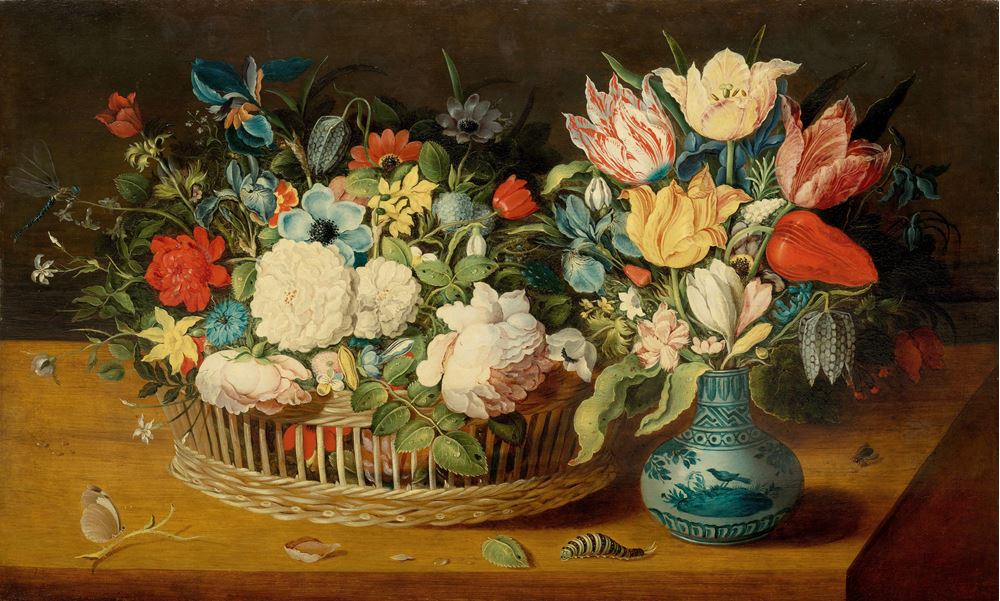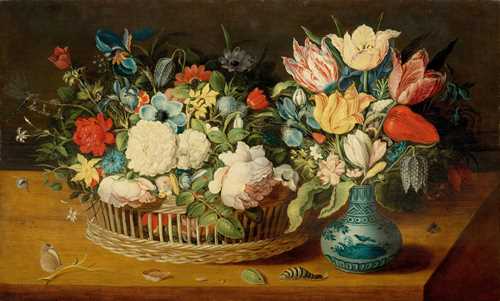
Lot 3031 - A176 Tableaux de Maîtres Anciens - mardi, 22. mars 2016, 14h30
OSIAS BEERT
Gutachten:#br#- Ingvar Bergström, 9.12.1975 und 24.4.1989.#br#- Marie-Louise Hairs, 26.5.1977.#br#- Laurens J. Bol, 28.5.1977.#br#- Dr. Walther Bernt, Juli 1978.#br##br#Provenienz:#br#- Privatsammlung Aspelin, Schweden.#br#- Privatsammlung Graf Carl von Rosen, Stockholm, um 1913.#br#- Auktion Bukowskis, Stockholm, 1920er.#br#- Gösta Stenman Gallery, Stockholm, 1934.#br#- Privatsammlung Counsellor Wallin, Stockholm.#br#- Auktion Bukowskis, Stockholm, 6.11.1975, Los 5.#br#- Kunsthandel Richard Green, London, 1976-77.#br#- Bei obigem erworben, Privatsammlung.#br##br#Literatur:#br#- Granberg, Olof: Inventaire général des trésors d'art peintures & sculptures, principalement de maîtres étrangers (non-Scandinaves) en Suède, Vol. III, Stockholm 1913, Nr. 97.#br#- Hairs, Marie-Louise: Les peintres Flamands de fleurs au XVIIe siècle, Brüssel 1985, Nr. 115, S. 342-343 (Abb.). #br#- Segal, Sam: Flowers and Nature, Den Haag 1990, S. 183 (unter Fussnote 2 erwähnt).#br##br#Das Gemälde ist im RKD, Den Haag, als ein eigenhändiges Werk Osias Beerts unter der Nr. 14703 archiviert. #br# #br#Osias Beert ist neben Jan Brueghel d. Ä. (1568-1625) und Ambrosius Bosschaert d. Ä. (1573-1621) einer der bedeutendsten Stilllebenmaler zu Beginn des 17. Jahrhunderts, der als Pionier die Entwicklung dieses Genres als eigenständige Gattung massgeblich geprägt hat. Neben reich gedeckten Imbisstafeln und Früchtestillleben spezialisierte er sich auf Blumenarrangements in Flechtkörben und chinesischen Porzellanvasen, zu denen das hier angebotene Stillleben gehört und als besonders meisterlich ausgeführt bezeichnet werden kann. Es zeichnet sich durch eine eindrückliche Motiv -und Farbenvielfalt aus, die durch kleine Insekten belebt wird, und ist in ausgezeichnetem Erhaltungszustand. #br# #br#Kürzlich in einer Privatsammlung wiederentdeckt, ist es ein Meisterwerk des Künstlers, dessen Entstehung um 1610 vermutet wird. Nur wenige seiner Werke sind signiert und keines ist datiert, obwohl zwei seiner Stillleben auf Kupfer mit dem Herstellungsdatum 1609 verso markiert sind. 1602 war Beert der Antwerpener Malergilde als Meister beigetreten, während er zuvor bei Andries van Baseroo in die Lehre gegangen war. Vermutlich malte Beert den Grossteil seiner Blumenstillleben in den 1610er Jahren, wie auch das Stillleben heute in einer Privatsammlung, welches stilistisch und kompositorisch sehr mit unserem Gemälde verwandt ist (RKD Archiv Nr. 14707). #br# #br#Für den Betrachter des 17. Jahrhunderts werden diese Blumenstillleben neben der Schönheit der Blüten auch eine symbolische Konnotation beinhaltet haben, so die Kurzlebigkeit der Schnittblumen und im weiteren Sinn die Kürze des Lebens, die Raupe und die Schmetterlinge wiederum führen die Wiedergeburt Christi vor Augen.#br# #br#Jan Brueghel d. Ä. dürfte mit seinen Blumenmotiven sicherlich Einfluss auf die künstlerische Entwicklung Osias Beerts genommen haben, dabei gelingt es allerdings Beert eine eigenständige Kompositionsform zu wählen und eine Vielfalt an Bildmotiven harmonisch gekonnt zu vereinen, so dass eine exquisite Opulenz und luxuriöse Fülle zur Schau gestellt wird, die charakteristisch ist für das Oeuvre von Osias Beert und damals wie heute den Betrachter fasziniert und erfreut. #br# #br#Dr. Klara Alen, der wir für ihre wissenschaftliche Auskunft zu diesem Gemälde danken, wird dieses in Kürze in der Fortsetzung ihrer Monographie über die Stillleben von Osias Beert aufnehmen und publizieren.
- Ingvar Bergström, 9.12.1975 and 24.4.1989.
- Marie-Louise Hairs, 26.5.1977.
- Laurens J. Bol, 28.5.1977.
- Dr. Walther Bernt, July 1978.
Provenance:
- Aspelin collection, Sweden.
- Count Carl von Rosen collection, Stockholm, circa 1913.
- Sale Bukowskis, Stockholm, 1920s.
- Gösta Stenman Gallery, Stockholm, 1934.
- Counsellor Wallin collection, Stockholm.
- Sale Bukowskis, Stockholm, 6.11.1975, lot 5.
- Richard Green Gallery, London, 1976-77.
- Private collection Alfred Studer, Lichtenstein, acquired from the above.
- Swiss private collection.
Literature:
- Olof Granberg: Inventaire général des trésors d'art peintures & sculptures, principalement de maîtres étrangers (non-Scandinaves) en Suède, Vol. III, Stockholm 1913, no. 97.
- Marie-Louise Hairs: Les peintres Flamands de fleurs au XVIIe siècle, Brussels 1985, no. 115, pp. 342-343 (ill.).
- Sam Segal: Flowers and Nature, The Hague 1990, p. 183 (mentioned in footnote 2).
This painting is archived under No. 14703 at the RKD, The Hague, as a work by the hand of Osias Beert.
Osias Beert, along with Jan Brueghel the Elder (1568-1625) and Ambrosius Bosschaert the Elder (1573-1621), was one of the most important still life painters of the early 17th century. As one of the early pioneers working in still life painting as an independent genre, Beert played an important role in its development. Alongside paintings of richly laid-out tables and still lifes of fruit, Beert favoured floral compositions, often with a blue & white porcelain vase, as in the example offered here. The present work is masterfully executed, with an impressive motif enlivened by a wide palette of colours and several insects. The condition of the work is impeccable.
Lately rediscovered in a private collection, this is a masterwork by the artist, believed to have been painted after 1610. Only a few of Beert’s works were signed and none are dated, although two of his still lifes on copper are marked on the reverse with the date 1609.
In 1602 Beert was accepted into the Guild of Saint Luke of Antwerp, prior to which he trained under Andries van Baseroo. Beert most likely painted the majority of his floral still lifes during the 1610s, such as a work in a private collection (RKD Archiv Nr. 14707) which is closely related through its composition and style to the painting offered here.
For the seventeenth-century viewer, this still life would not only have represented a beautiful depiction of flowers, but would have carried strong symbolic connotations: the brief lifespan of the cut flowers calls to mind the brevity of human life, and the caterpillar and butterfly symbolize the resurrection of Christ.
Although the floral motifs of Jan Breughel the Elder certainly had some influence on Osias Beert’s artistic development, Beert brilliantly succeeded in developing his own formal language, and by combining a diversity of motifs in a harmonious manner, creates an atmosphere of exquisite opulence and luxurious plenitude that never ceases to fascinate and delight the senses.
Dr. Klara Alen, to whom we are grateful for her scholarly research on this painting, will include this work in her forthcoming monograph on the still lifes of Osias Beert.
CHF 400 000 / 500 000 | (€ 412 370 / 515 460)
Vendu pour CHF 480 500 (frais inclus)
Aucune responsabilité n'est prise quant à l´exactitude de ces informations.

